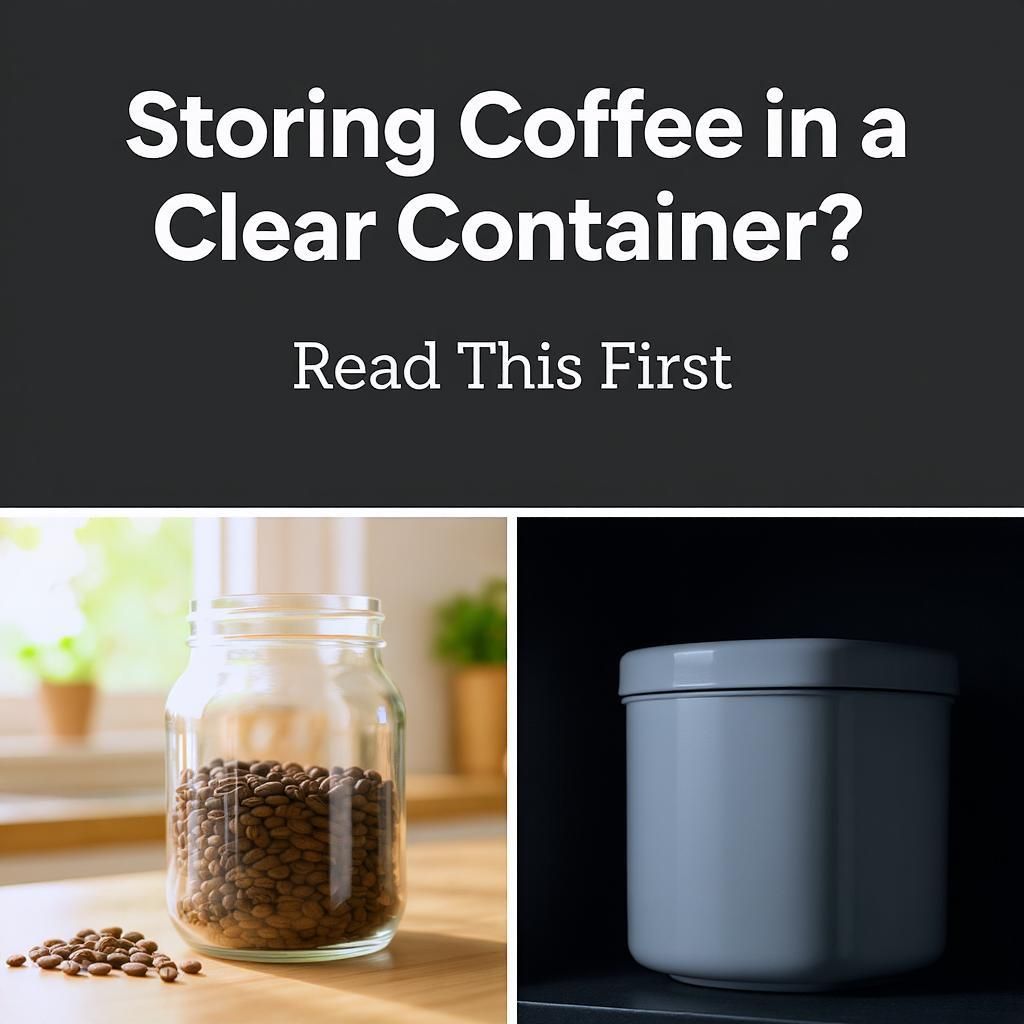As an Amazon Associate CoffeeXplore.com earns from qualifying purchases.
Storing Coffee in a Clear Container? Read This First
You’ve seen them on countertops and in magazines: beautiful, clear glass jars showcasing rich, dark coffee beans. It’s an aesthetic choice that feels clean and organized. But as you reach for that jar, a nagging question arises: is this stylish setup secretly ruining your coffee? You want your kitchen to look great, but you also want your morning brew to taste incredible. Can you really have both when you decide to store coffee in a clear container?
The short answer is no, you generally shouldn’t store coffee in a clear container. Light is one of coffee’s four main enemies, and exposure will quickly degrade the delicate flavors and aromas you love, unless that container is kept in a completely dark place.
Leveraging extensive analysis of expert recommendations and coffee science, this guide unpacks exactly why light matters, what the best containers are made of, and how to store your beans for peak freshness. We’ll explore the science of coffee staling and provide actionable steps to ensure every cup you brew is as flavorful as possible, even if you love the look of a clear jar.
Key Facts
- Air is Public Enemy #1: According to coffee experts, oxygen is the single most destructive factor in coffee staling, causing a process called oxidation that robs beans of their flavor far faster than any other element.
- Light Degrades Flavor: As highlighted by analysis from sources like milkhoney.coffee, light—specifically UV rays—actively breaks down the essential oils and aromatic compounds in coffee, leading to a dull, stale, and less vibrant taste.
- Material Matters Most: Opaque, taste-neutral materials like stainless steel and ceramic are widely considered the best for coffee storage because they provide a total barrier against light and do not impart any unwanted flavors onto the beans.
- Freshness Has a Deadline: Even with perfect storage, whole coffee beans have a peak flavor window. Data suggests they are at their absolute best between one and four weeks after their roast date. Proper storage slows staling but cannot stop it entirely.
- Vacuum-Sealed is the Gold Standard: While an airtight seal is crucial, vacuum-sealed canisters that actively remove oxygen from the container, such as the Fellow Atmos, are considered superior for creating the most protective environment possible.
The Verdict: Can You Store Coffee in a Clear Container?
Generally, no. Coffee should not be stored in a clear container unless that container is kept in a completely dark place, like a pantry or cabinet, as light degrades its flavor.
This is the fundamental rule of proper coffee storage. While a clear glass or plastic container might look appealing on your kitchen counter, you are exposing your precious beans to one of their greatest enemies. Every moment they sit in the light, their complex and delicate flavors are breaking down. This degradation is a chemical process that, once it happens, is irreversible. You can’t “un-stale” your coffee.
So, what does this mean for that beautiful glass jar you’ve been eyeing for your coffee beans? It means you have a choice to make: prioritize aesthetics on the counter or prioritize the flavor in your cup. The good news is, you can still use that clear container, but only if you commit to storing it correctly—away from any and all light sources.
Why Coffee Goes Stale: Understanding the 4 Enemies of Freshness
To truly understand why a can coffee be stored in a clear container is a bad idea, you need to know what you’re fighting against. Coffee beans are a delicate agricultural product, and once roasted, they begin a rapid process of staling. Authoritative sources and coffee experts unanimously agree that freshness is a battle fought on four fronts. To keep your coffee tasting its best, you must protect it from these four primary enemies.

- Air (Oxygen): This is the arch-nemesis of fresh coffee. When oxygen interacts with the fragile oils and soluble compounds in your coffee beans, it causes oxidation. This chemical reaction makes the beans lose their aroma and develop a flat, stale, and sometimes rancid taste. An airtight seal is your first and most important line of defense.
- Light: This is the core reason why clear containers are a problem. Direct exposure to light, especially sunlight and its UV rays, acts like a catalyst, speeding up the chemical reactions that break down the oils and aromatic compounds. This results in a significant loss of flavor long before you even grind the beans.
- Moisture: Coffee is hygroscopic, which means it absorbs moisture from the air around it. Any moisture will dissolve and extract the soluble flavor compounds prematurely. This not only ruins the flavor but can also create a breeding ground for mold. This is why storing coffee in the refrigerator or freezer is often discouraged unless done with extreme care.
- Heat: Heat is another catalyst that accelerates the degradation process. It causes the delicate oils in the beans to turn rancid more quickly and speeds up the release of volatile aromatic compounds. You want to store your coffee in a cool, stable environment, away from the oven, stove, or any sunny spots in your kitchen.
Did you know? According to coffee experts, oxygen is the single most critical factor in coffee staling, even more so than light! However, all four enemies work together to ruin your brew, which is why a comprehensive storage solution is so vital.
The Problem with Light Exposure
Let’s zoom in on the specific issue with clear containers. It’s not the glass or plastic itself that’s the problem; it’s their transparency. Light doesn’t just make the beans visible; it actively harms them.

Here’s exactly what happens when you store coffee in a see-through jar on your counter:
- Compound Breakdown: Light, and particularly the UV rays within it, provides the energy needed to break down the complex cellular structures within the roasted coffee bean.
- Oil Degradation: The flavorful oils that give coffee its body and rich taste begin to degrade and turn rancid when exposed to light, leading to off-flavors.
- Aroma Loss: The wonderful smell of fresh coffee comes from volatile aromatic compounds. Light accelerates the process of these compounds escaping the bean, leaving you with a brew that smells and tastes dull and lifeless.
Essentially, storing coffee in a clear container is like leaving it out to get a sunburn. The constant exposure slowly but surely destroys the very qualities that make it delicious. This is why coffee professionals are so insistent on using opaque containers.
Why Air (Oxygen) is the #1 Threat
While light is a significant problem, it’s crucial to understand that air is an even bigger one. You could have the most light-proof container in the world, but if it doesn’t seal properly, your coffee will still go stale in a matter of days.
The single most important feature of any coffee container is an airtight seal. Preventing oxygen from reaching the beans is the primary goal of coffee storage and the number one way to combat the staling process of oxidation.
This is a point of consensus among all major coffee authorities. The oxidation process begins the moment roasted beans are exposed to air. A truly airtight seal stops this process in its tracks by cutting off the supply of fresh oxygen. This is why a high-quality coffee bag from a specialty roaster often has a one-way valve—it lets the CO2 released by fresh beans out without letting any oxygen in.
Pro Tip: Even the most opaque container is useless if it doesn’t have an airtight seal. Always prioritize the quality of the seal over the material of the container when making a choice. If you have to choose between a clear airtight jar stored in a dark cabinet and an opaque, unsealed canister on the counter, the clear jar in the dark is the better option every time.
Coffee Container Showdown: Choosing the Best Material
Now that we’ve established the principles—block light and block air—let’s look at the practical application. When you’re shopping for a coffee canister, you’ll find they are typically made from four common materials: stainless steel, ceramic, glass, and plastic. Here’s how they stack up based on the key criteria for keeping coffee fresh.
| Material | Light Protection | Taste-Neutrality | Pros | Cons |
|---|---|---|---|---|
| Stainless Steel | Excellent | Excellent | Durable, completely opaque, non-reactive, easy to clean. | Can be more expensive. |
| Ceramic | Excellent | Excellent | Completely opaque, non-reactive, often aesthetically pleasing. | Can be fragile, heavy, and potentially expensive. |
| Clear Glass | Poor | Excellent | Non-reactive (doesn’t affect taste), easy to see contents. | Allows full light exposure, requires dark storage. |
| Plastic | Varies | Poor to Fair | Lightweight, inexpensive. | Can absorb coffee oils and impart flavors, may not be fully opaque. |
As the data clearly shows, opaque, taste-neutral materials like stainless steel and ceramic are the best for coffee storage because they block light and do not impart unwanted flavors.
The Case for Opaque: Stainless Steel & Ceramic
There’s a reason why the highest-rated coffee canisters are almost always made of stainless steel or ceramic. These materials are the champions of coffee freshness because they offer a complete solution to the light problem.
Here are the key advantages of choosing an opaque container:
- Total Light Blockage: This is the most obvious benefit. Stainless steel and ceramic are inherently opaque. You don’t have to worry about where you store them; they protect your beans from light whether they’re on a sunny counter or in a dark pantry.
- Non-Reactive Nature: Both materials are non-porous and non-reactive. This means they won’t absorb the oils from your coffee or leach any unwanted tastes or odors into your beans, preserving the pure, original flavor profile created by the roaster. This is a key point highlighted by sources like milkhoney.coffee.
- Durability and Longevity: Stainless steel is particularly durable and can withstand drops and dings. A high-quality canister is a long-term investment in better-tasting coffee.
When you invest in a stainless steel or ceramic canister, you are buying peace of mind. You know your beans are protected from light, and as long as it has a good seal, they are also protected from air.
Using Clear Glass & Plastic: The Right Way and the Wrong Way
So, what if you already have a clear glass jar or are tempted by an inexpensive plastic one? Can you still use them? The answer is yes, but with critical caveats.
Think of a clear container like a window. It’s great for seeing what’s inside, but you wouldn’t want your coffee to get a sunburn. If you absolutely must use a clear container, you need to treat it like a vampire: keep it out of the light.

If you MUST use a clear glass container, follow these steps:
1. Ensure it’s Airtight: First and foremost, make sure it has a gasket or seal that prevents air from getting in. A simple screw-top jar is not enough.
2. Find a Dark Home: Store the container in a location that is completely dark 24/7. A deep pantry, a drawer, or a kitchen cabinet that isn’t opened frequently are all good options.
3. Keep it Cool: Make sure its dark home is also away from heat sources like your dishwasher, oven, or refrigerator vents.
When it comes to plastic, the warnings are even stronger.
Warning: Avoid storing coffee in standard plastic containers. Plastic is often porous and can absorb the oils and aromas from your coffee. Over time, these old, rancid oils can taint fresh batches of beans. Furthermore, cheap plastic may not be taste-neutral, imparting a chemical flavor to your coffee.
If you must use plastic, ensure it is completely opaque, designated as food-grade, BPA-free, and has a very secure airtight seal. Even then, stainless steel or ceramic remains a far superior choice for long-term flavor preservation.
Beyond Material: Other Crucial Storage Features
Choosing the right material is a huge step, but it’s not the only factor. The best coffee canisters on the market today incorporate several design features that work together to create the ultimate fortress for your beans. When you’re evaluating a container, look for these critical elements.
- Airtight Seal: We’ve said it before, but it bears repeating. Look for a robust silicone or rubber gasket that creates a true seal. A simple friction-fit lid is not enough to prevent the slow ingress of oxygen.
- Vacuum-Sealed Technology: The best-in-class containers take airtightness a step further. Products like the well-regarded Fellow Atmos feature a mechanism to actively pump the air out of the canister after you’ve sealed it. By removing most of the oxygen, you dramatically slow the oxidation process, keeping beans fresher for even longer.
- Appropriate Capacity: Bigger is not always better. Air is the enemy, and a half-empty container is half-full of flavor-destroying oxygen. Choose a container size that will be mostly full with your typical purchase. As the data suggests, a 1.2-liter canister that holds about a pound of coffee is a great size for most home users.
- Easy Cleaning: Coffee oils will build up on the inside of your container over time. If not cleaned, these oils can turn rancid and spoil the taste of new beans. Look for a container with a wide mouth that is easy to wash by hand.
Pro Tip: When choosing a container size, aim to buy one that will be mostly full with your typical bag of coffee. Less empty space means less air to degrade your beans!
To ensure you’re equipped with the best tools to protect your beans, consider investing in a top-rated coffee canister. These products are specifically designed with features like opacity and airtight seals to maximize freshness.
FAQs About Storing Coffee
Even with all this information, you might still have a few lingering questions. Here are direct answers to some of the most common queries about how to store coffee and whether you can store coffee in a clear container.
Is it okay to store coffee in a clear container?
Only if the clear container is stored in a completely dark environment like a cabinet or pantry. If the container will be left out on a counter or shelf where it is exposed to any ambient light, you must not use a clear container. The light will damage the coffee’s flavor and aroma over time.
What is the absolute best type of container for storing coffee?
The best container is an opaque (stainless steel or ceramic), taste-neutral, vacuum-sealed canister that is sized appropriately for the amount of coffee you use. This combination tackles all four enemies of freshness: it blocks light, it removes oxygen, its material doesn’t affect flavor, and it should be stored in a cool place.
Does coffee have to be kept in an airtight container?
Yes, absolutely. An airtight seal is the single most important feature for any coffee container. It is your primary defense against oxygen, which is the main cause of coffee going stale. Without an airtight seal, even an opaque container stored in a cool, dark place will fail to keep your coffee fresh for long.
How long will coffee beans last in an airtight container?
Even in a perfect container, whole coffee beans are best used within 1 to 4 weeks after their roast date. This is their peak flavor window. Proper storage in an opaque, airtight container slows the staling process significantly, extending its drinkable life, but it doesn’t stop it entirely. The goal is to preserve that peak flavor for as long as possible.
Is it better to leave coffee in the original bag?
It depends on the bag. A high-quality bag from a specialty roaster with a one-way degassing valve and a resealable zip-lock is far better than a poor-quality, non-airtight container. However, these bags are not ideal for long-term storage. A dedicated opaque, airtight canister is superior for keeping beans fresh for more than a week or two.
Final Summary: The Keys to Fresh Coffee Storage
Protecting the flavor of your coffee comes down to a few simple, science-backed principles. While it can seem complex, the rules for perfect storage are straightforward. You don’t have to settle for stale, lifeless coffee. By making a few smart choices, you can ensure every cup is vibrant and delicious.
The debate over whether you can coffee be stored in a clear container is officially settled: only if it’s kept in total darkness. For everyone else, the path to better coffee is opaque.
Here are the most critical takeaways for perfect coffee storage:
- Fight the Four Enemies: Your storage solution must protect your beans from Air, Light, Moisture, and Heat.
- Prioritize the Seal: An airtight seal is non-negotiable. A vacuum seal that removes oxygen is even better. This is your number one defense against staling.
- Embrace the Dark: Choose an opaque container made from stainless steel or ceramic. If you must use a clear container, it must live in a dark cabinet or pantry, never on the counter.
- Buy Fresh, Store Smart: Remember that storage only slows down staling. Always start with freshly roasted beans and aim to use them within a few weeks of the roast date for the best possible flavor.
Now that you know the science, go rescue your coffee beans and give them the home they deserve! Your morning cup will thank you for it.
Last update on 2025-12-13 / Affiliate links / Images from Amazon Product Advertising API

